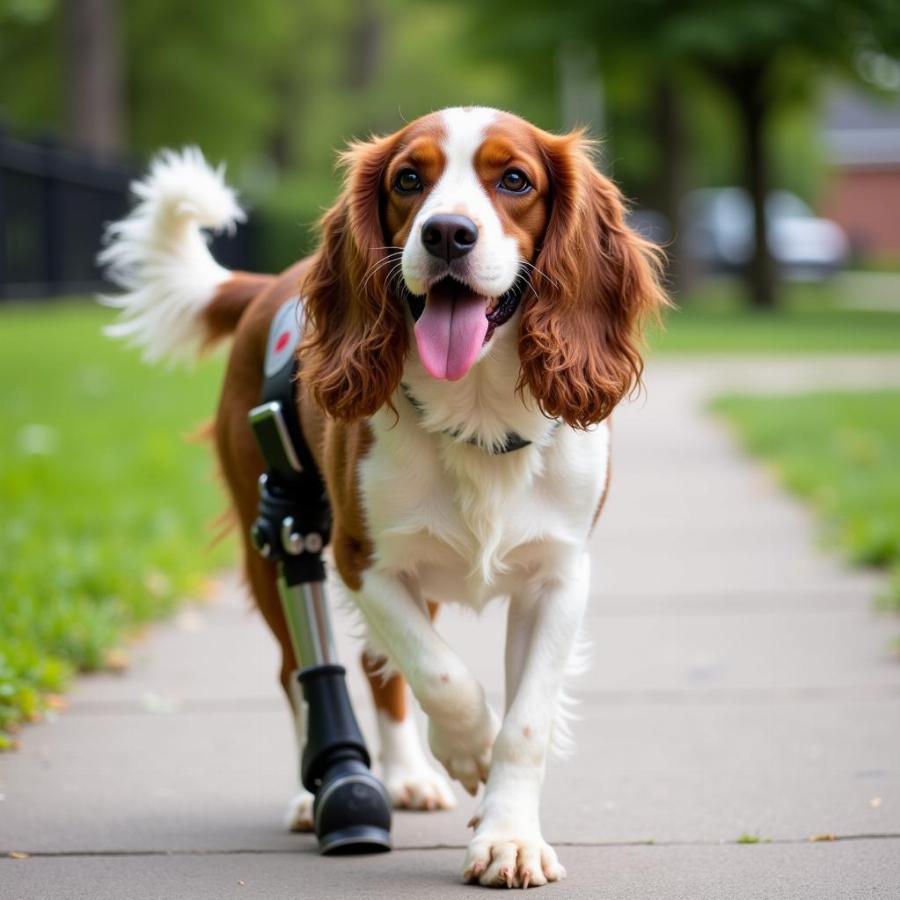If you’re reading this, chances are you’re worried because your furry friend is suddenly walking with a limp in their back leg. Don’t panic! It’s a common problem in dogs, and while it can sometimes signal a serious issue, there are also many causes that are easily treatable. Let’s delve into the potential reasons behind your dog’s limping and when it’s crucial to seek veterinary care.
Common Causes of Back Leg Limping in Dogs
There’s a wide range of reasons why your dog might be limping on a back leg. Some of the most common culprits include:
- Minor Injuries: Just like us, dogs can experience sprains, strains, and small tears in ligaments or tendons, especially if they’re particularly active. These injuries often occur during playtime, running, or even an awkward landing.
- Paw Problems: A thorn, cut, or abscess on the paw can cause significant discomfort, leading to limping. Always check your dog’s paws carefully if you notice limping.
- Arthritis: As dogs age, they can develop arthritis, particularly in their hips and knees. This degenerative joint disease causes pain and inflammation, resulting in stiffness and difficulty walking.
- Cruciate Ligament Injuries: Similar to the ACL in humans, a cruciate ligament tear or rupture is a common and potentially serious injury in dogs, particularly in larger breeds. It causes sudden and severe lameness.
- Patellar Luxation: This condition occurs when the kneecap (patella) dislocates from its normal position, causing pain and limping. It’s more common in small breeds.
When to Worry: Signs Your Dog Needs Immediate Vet Care
While a mild limp might resolve on its own with some rest, certain symptoms warrant a trip to the vet immediately. Seek urgent care if your dog:
- Has a sudden, non-weight-bearing limp: This means your dog completely refuses to put weight on the affected leg.
- Is in severe pain: Whining, yelping, or crying when the leg is touched or moved.
- Has swelling in the leg or paw.
- Has a dangling leg that appears dislocated.
- Is running a fever.
- Is showing signs of lethargy or loss of appetite.
Diagnosing the Limp: What to Expect at the Vet
Your veterinarian will perform a thorough physical exam and ask about your dog’s medical history and any recent activities. They may also recommend diagnostic tests, such as:
- X-rays: To check for fractures, dislocations, arthritis, or other bone abnormalities.
- Blood tests: To rule out infections or other underlying medical conditions.
- Joint fluid analysis: To examine the fluid surrounding the joint for signs of infection or inflammation.
Treatment Options: Getting Your Dog Back on Four Paws
The treatment for your dog’s limping will depend on the underlying cause. It may include:
- Rest and restricted activity: For minor sprains and strains.
- Medications: Pain relievers, anti-inflammatories, or antibiotics.
- Supplements: Joint supplements containing glucosamine and chondroitin can help with arthritis.
- Surgery: In cases of severe injuries, such as cruciate ligament tears, surgery may be necessary.
- Physical therapy: To help regain mobility and strength after injury or surgery.
 Happy dog walking with a leg brace
Happy dog walking with a leg brace
Preventing Future Limping: Keeping Your Dog’s Legs Healthy
While not all causes of limping are preventable, there are steps you can take to minimize the risks:
- Maintain a healthy weight: Excess weight puts added strain on joints.
- Provide regular exercise: Keeping your dog active strengthens muscles and supports joints.
- Use ramps or stairs: For older dogs or those with arthritis, ramps can help them avoid jumping on and off furniture.
- Warm up before exercise: Just like athletes, dogs need to warm up their muscles before strenuous activity.
- Schedule regular vet checkups: Catching problems early can prevent them from worsening.
Why is my dog limping on back leg?
Your dog might be limping on a back leg due to a range of issues like minor injuries, paw problems, arthritis, cruciate ligament injuries, or patellar luxation. Observing your dog’s behavior and consulting a vet is essential for proper diagnosis and treatment.
Should I worry if my dog is limping on and off?
While occasional limping after strenuous activity might not be a cause for immediate concern, persistent or worsening limping, even if intermittent, warrants a vet visit to rule out any underlying issues.
What can I give my dog for a limping back leg?
Never give your dog human pain relievers without consulting your vet, as they can be toxic to dogs. Your veterinarian can prescribe safe and effective pain management options tailored to your dog’s needs and the underlying cause of the limping.
Remember, you know your dog best! If you notice any changes in their gait or behavior, it’s always better to err on the side of caution and consult with your veterinarian. They can help you determine the cause of the limping and create a treatment plan to get your furry friend back to their happy, active self.
Need More Help? Contact Beaut Dogs!
Finding the right information and support for your canine companion is crucial, and that’s where Beaut Dogs comes in. We provide a wealth of knowledge on dog breeds, health, nutrition, training, and care. If you need personalized assistance or have specific questions about your dog’s limping, don’t hesitate to reach out to our team of experts. Email us at [email protected] for detailed and accurate guidance. Let Beaut Dogs be your trusted partner in providing the best possible care for your beloved furry friend!